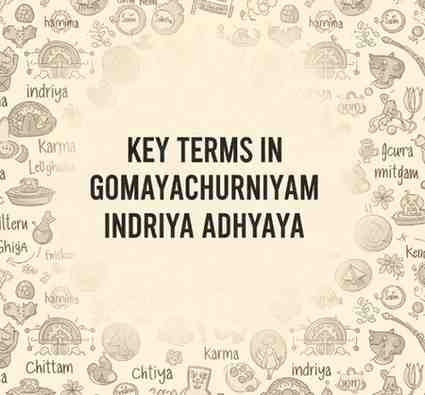
Your Account
Designed by Zeptt Technologies

Indriya Sthana is the third section (Sthana) of Charaka Samhita, focusing on prognostic features, particularly signs indicating impending death (Arishta Lakshana).
The Gomayachurniyam Adhyaya is the 12th chapter of Indriya Sthana and holds clinical, philosophical, and prognostic significance.
It offers observational, ritualistic, and empirical methods to determine the prognosis of a dying or critically ill patient.
The chapter is rich in Arishta Lakshanas, metaphysical perceptions, and symbolic interpretations of signs related to Prana (life force).
JUSTIFICATION OF THE POSITION OF THE CHAPTER
Positioned as the 12th chapter, it follows earlier discussions on subtle prognostic signs (like Swapnadi Indriya and Panchendriya Lakshana).
Sequential development:
Previous chapters emphasize sensory and dream-related signs.
This chapter introduces symbolic and environmental omens along with specific rituals and materials used in testing prognosis.
Logical progression:
Starts with internal signs (Antar Arishta).
Gradually moves towards external omens (Bahya Arishta).
Emphasizes the transition from clinical observation to intuitive and ritualistic diagnostics.
Sanskrit Reference
गोमयचूर्णं तु गृहीत्वा सम्यक् पृथक् पृथक्समं प्रक्षिपेदूर्ध्वबद्धे पात्रे जले च तस्मिन् ॥
तदा समुद्धृतं सम्यग्दक्षिणावर्तमेव वा ।
माङ्गल्यं च सदा कुर्याद्दूतमायातमस्तु वा ॥
(Cha In 12/3)
KEY TERMS EXPLAINED
MUMURSHU
Derived from root 'mr̥' (to die), Mumurshu means "one who is about to die."
Describes a patient who is terminally ill and displaying Arishta Lakshanas.
Clinical signs may include:
Fixed or deviated gaze.
Inability to perceive surroundings.
Discolored tongue or skin.
Dry or cracked voice.
Urdhvaroma (hair standing upwards).
Modern Correlation: Terminally ill or moribund state in ICU patients; characterized by multi-organ failure or Glasgow Coma Scale <5.
Sanskrit Reference
अथ खलु यं मन्येतैतन्मुच्यत इत्येव मे नूनं नान्तरं प्राणस्येति ॥
(Cha In 12/1)
PRASASTA DUTA
Duta = messenger or attendant of the patient visiting the physician on behalf of the patient.
Prasasta = auspicious, qualified, clear communicator.
A Prasasta Duta is:
Calm, composed, not panicking.
Well-spoken and respectful.
Arrives at an appropriate time without delay.
Does not bring inauspicious signs (e.g., sneezing, tripping).
Charaka emphasized examining the Duta to infer the patient’s prognosis.
Modern Correlation: Caregiver’s psychological, verbal and behavioral presentation may reflect the patient’s condition and aid in assessing prognosis (family-centered care dynamics).
Sanskrit Reference
यस्मिन् श्लक्ष्णं विनीतं च प्रीतिसंयुक्तभाषिणम् ।
दूतं प्राहु: प्रशस्तं च तं शुभायै विनिर्दिशेत् ॥
(Cha In 9/4)
MANGALIKA DRAVYA
Mangalika = auspicious; Dravya = substance.
Substances or objects considered auspicious and used to predict positive prognosis.
Examples:
Gomaya (cow dung powder): considered pure and spiritually potent in Ayurveda.
Tulasi, Ghee lamps, and sacred water.
Gomaya Churna Test:
Cow dung powder is sprinkled over water in a vessel.
If the powder swirls clockwise or collects in center, it is auspicious.
If it sinks, spreads to sides, or moves anticlockwise, it's inauspicious.
Modern Correlation: Placebo and belief-based psychological effect; patient and relatives’ beliefs in spiritual healing can influence perception of outcome.
Sanskrit Reference
गोमयचूर्णस्य तथोत्तानं भद्रं भविष्यति।
अन्यथा च यदि स्याद्दोषानुबन्धितं तदिति विचार्यम् ॥
(Cha In 12/4)
GOMAYACHURNIYAM PARIKSHA (COW DUNG POWDER TEST)
Diagnostic ritual to determine life expectancy through symbolism.
Procedure:
Gomaya Churna sprinkled over water in a clean vessel suspended in air.
Observed for direction, spread, dissolution or aggregation.
Interpretation:
Clockwise spiral or floating in center: Shubha Lakshana (good prognosis).
Sinking or scattering: Ashubha Lakshana (poor prognosis).
Philosophical Implication:
Connection between universal cosmic order and individual life force.
Reflects Ayurvedic non-dualistic view that the internal and external cosmos mirror each other.
RELEVANCE TO MODERN MEDICINE
Clinical Parallels:
ICU scoring systems (APACHE, SOFA scores) are modern equivalents of prognosis assessment.
Terminal signs such as fixed pupils, Cheyne-Stokes breathing match Arishta Lakshanas.
Psycho-social Interpretation:
Role of family and environment (Duta and Dravya) mirrors importance of psychosocial assessment in palliative care.
Ethics and End-of-Life Care:
Ayurveda discusses death as a transition, not an end.
Offers a holistic view of spiritual preparedness and rituals to maintain dignity in dying.